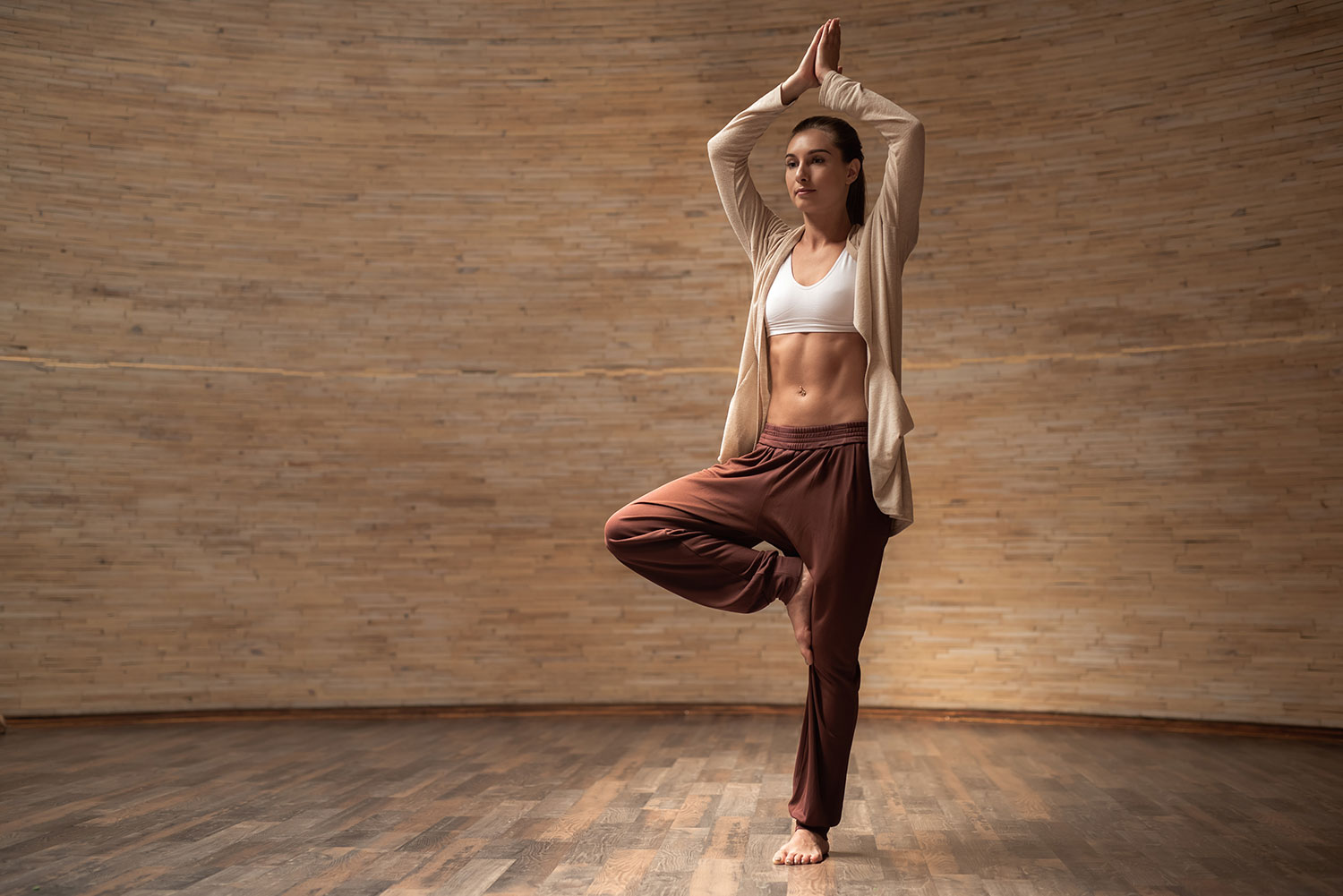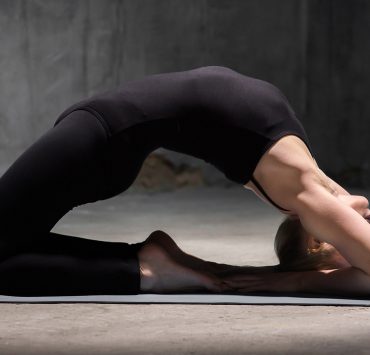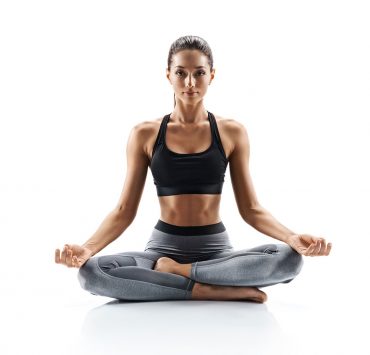
Susan views the world through a lens of spirituality, health,…
Standing Poses build strength, confidence, balance, and form a solid foundation for your yoga practice. They help deepen your body awareness to every part of your body, and also help focus your awareness on your connection to the earth.
Many yoga standing poses require you to hold the pose in stillness. This helps improve concentration and stillness of the mind.
These ten asana are suitable for any level of yoga practitioner and can help you go deeper into your practice. They form the basis for other more advance asana and the focus, balance, strength, and stability that they cultivate will follow you even as you practice a yogic life off the mat.
Tadasana — Mountain Pose

Tadasana is often the starting point of most standing yoga poses. It is said that all yoga asana are no more than three movements away from Tadasana.
— Stand at the top of your mat and start to feel your entire body from your feet to your crown. Allow yourself to sway a little bit from side to side and front and back to feel where your own center of gravity is for your body.
— Bring your feet together or hip width apart – whichever is more comfortable for your body.
— Activate your thighs to lift up your kneecaps. Keep a micro bend in your knees, especially if you are hyper flexible.
— Allow your fingers to relax with your palms facing forward or inwards towards your body. Let them feel natural and unforced.
— Lengthen your spine by engaging your core and point your tailbone downwards. Externally rotate your thighs to activate your gluteus minimus. Inhale as you roll your shoulders up and exhale as you roll them down and back to expand your chest. Slightly tilt your chin down to feel the extension in the back of your neck and feel yourself get taller through the crown of your head.
Utthita Trikonasana — Extended Triangle Pose

Triangle Pose strengthens your legs, core, and arms. It also helps to expand your groin, hips, and chest. It’s one of the more challenging beginner yoga standing poses, especially when held for longer periods of time but it’s a optimal whole-body activator because of all the muscle groups involved.
The most common alignment mistake made in Trikonasana is allowing your upper body to lean forward, thus collapsing into your chest. To prevent this, keep you chest expanded as you focus on reaching both upwards and downwards through your arms.
— Begin in Tadasana.
— Step your right leg backwards and face the long side of your mat. At the same time, open up your arms to a horizontal straight line. If comfortable, keep the distance of your heels the same distance as your wrist.
— Rotate your front foot so that your left toes face the front of your mat and your right toes face the side of your mat. Keep your palms facing downwards and extending at both ends.
— Look over your front shoulder and reach forward with your left arm. Push your right hip towards the back of your mat. Keep your chest extended and on the same plane as your hips.
— Without folding forward, hinge sideways from your hips so that your left hand extends downwards (or let your hand rest anywhere on your left leg, except on your knee) and reach your right arm upwards toward the sky.
— Shift your gaze from downwards to upwards past your fingertips. (If this is too much on your neck, look straight without twisting your neck or allow your head and neck to relax.)
Ardva Mukha Svanasana — Downward Facing Dog Pose

Downward Facing Dog can seem like a challenging pose when you first practice it, but eventually, this inversion can become a welcome resting pose in-between dynamic vinyasa sequences. It helps to strengthen your core, shoulders, and arms. It also lengthens your hamstrings and increases circulation and metabolism.
— Come to your hands and knees on your mat. Align your wrists underneath your shoulders and your knees underneath your hips so that you form a box shaped space underneath you. Move your palms a few inches forward and spread your fingers as wide as you can. Press firmly into your fingertips to get a solid connection with the earth.
— Inhale deeply and when you exhale, push your hands into your mat and push your hips back and up. Straighten your knees and aim for your heels to touch the ground, but if they can’t, it’s alright to keep your knees bent and heels up.
— Hug your shoulders in, is if you want your armpits to face each other. This will help broaden your back and lengthen your spine.
— Look in between your feet or relax your neck.
Vriksasana — Tree Pose

Vriksasana, or Tree Pose, is a well-known standing balancing yoga pose that works on balance, strengthening your legs, and increases focus and mental clarity. The trick here is to keep a soft gaze on a Drishti, or a fixed point of focus in front of you to concentrate on.
— Start by standing on your mat in Tadasana.
— Keep your focus on a Drishti in front of you and transfer your weight to your right foot. Engage your right thigh and keep a micro bend in your knee.
— Bring your left foot to your right inner thigh. Press the sole of your foot into your thigh and equally push your thigh towards your foot so the energy goes towards your center.
— Keep your palms together in front of your chest in Namaste mudra, or raise them above your head slowly if you can keep balance.
— For an added challenge, close your eyes as you hold your balance, keeping your Drishti within.
Utkatasana — Chair Pose

Chair Pose is a challenge for your entire body. It works your legs, hips, glutes, back, and shoulders, and stretches your Achilles tendon. Make sure you have adequately stretched and warmed up before practicing Utkatasana and be mindful of your personal limits in this pose.
— Stand in Tadasana. Keeping your feet together or hip width apart will work different parts of your gluteus so take the stance that is better for your personal balance to begin with.
— Hinge from your hips to sit in an imaginary chair. Check that your knees don’t go further forward than you toes.
— Expand your chest and raise your arms straight up above your head with your palms facing each other. Lengthen your spine by pointing your tailbone downwards.
— If your feet are together, push your thighs into each other to help with stability. Whether your feet are together or not, engage your core, including your side body to lengthen up through your arms.
Garudasana — Eagle Pose

This pose is translated into English as Eagle Pose, but the Garuda is a mythical creature who was the vehicle of Vishnu and king of birds. He is a friend of man who represents sustained attention towards self-sacrifice and service to protect creation. The enemy of Garuda are snakes and the ego.
— Begin in Tadasana.
— Hinge at your hips to sit in an imaginary chair. Raise your right leg so it wraps around your left leg at the thigh and, if possible, at your ankles too.
— At the same time, bring your arms in front of your and wrap your right arm underneath your left arm and, also if possible, at your wrists so that your palms face each other and tough.
— Keep your elbows at the same level as your shoulders and fingers pointing straight upwards. Keep your gaze past your fingertips and keep squeezing your legs for help with stability.
— Throughout the pose, keep lengthening your spine by pointing your tailbone downwards and keep most of your weight on your heels rather than on your toes.
Uttanasana — Forward Fold Pose

Uttanasana is a standing inversion yoga pose that helps relieve your lower back and also wakes up your hamstrings. Because of the increased blood circulation to the head, it is said that this asana relieves headaches and eases anxiety. The full expression of Forward Fold is actually considered an intermediate yoga pose, but even beginners can practice this pose by being mindful of the limits of your body and, whenever needed, using props like yoga blocks to lessen the effort on your hamstrings while they lengthen.
— Start in Tadasana with your feet at hip width distance apart.
— On an inhale, raise your arms above your head, keeping your spine and neck long, and chest expanded.
— Hinge from your hips as you exhale, keeping your spine long. Think of reaching forward rather than downwards. — When you reach the full extent of your fold, bring your arms towards the ground, keeping them straight. Allow your hands to rest on the floor, or anywhere they reach on your legs without straining or creating a bend in your back. Use yoga blocks to help if necessary.
— Relax your neck and let your head hang.
Malasana — Garland Pose aka Full Yogic Squat Pose

Malasana, or Garland Pose, is the name given to various squatting poses in yoga. This position may be a challenge for some, especially for people from cultures who do not squat as a primary resting position in daily life. It is a grounding pose that opens the hips, groin, lower back, and sacrum, and also stretches and increases ankle mobility.
— Begin in Tadasana with your feet slightly wider than hip width apart.
— Bend your knees and sink down until your hips are lower than your knees. As much as possible, keep your heels on the ground and toes pointing forward.
— Place your palms together in front of your heart space and use your elbows to push your knees out.
— Lengthen your spine by pointing your tailbone downwards and expanding you chest.
Ardha Chandrasana — Half Moon Pose

The dual energies of the sun and moon are important in the Hatha Yoga lineage which is what most modern yoga classes branched off from. Ardha Chandrasana literally translates as Half Moon Pose. It is an asymmetrical standing balancing pose that activates the lunar energy in your system. It balances your body while extending your torso and leg laterally.
It is easy to move into Arhda Chandrasana from Trikonasana.
— From Triangle Pose, with your left leg forward, bend your knee and shift your weight to your left foot. At the same time, lift your back leg to be horizontal with the ground.
— Raise your right arm so that your fingertips point towards the sky and your left fingertips point towards the ground by your left foot. Use a block under your left hand to help with balance if needed.
— As your straighten your left knee, stack your hips over each other to open your hips and expand your chest. Do not allow your chest to rotate towards the floor.
— Keep your gaze on the floor to begin and if you can keep the balance, shift to look past your upraised right fingertips.
Parsvottasana — Intense Side Stretch Pose aka Pyramid Pose

Parsvottanasana is a stabilizing posture that lengthens your hamstrings as well as your side body by your chest. Just like the Pyramids for which this pose is named after, Parsvottanasana is grounding and requires you to pay attention to your angles and alignment to support the asana.
— Start by standing at the top of your mat in Tadasana.
— Step your right foot back just enough to stand comfortably. No need to bring it as far back as your would for Warrior 1, for example.
— Bring your palms together behind your back in Namaste. If you cannot comfortably do this, you may reach for opposite elbows, or keep your hands on your hips.
— Engage your core and point your tailbone downwards to elongate your spine. Roll your shoulders down and back to expand your chest.
— Inhale to expand your torso and bend your trunk forward halfway as you exhale. Inhale again to lengthen your spine again and exhale to fold forward the rest of the way, aiming to rest your forehead on your left knee.
What's Your Reaction?
Susan views the world through a lens of spirituality, health, and compassion. Her positive outlook on life shines through her writing, which is heavily focused on yogic living, meditation, and conscious eating.














